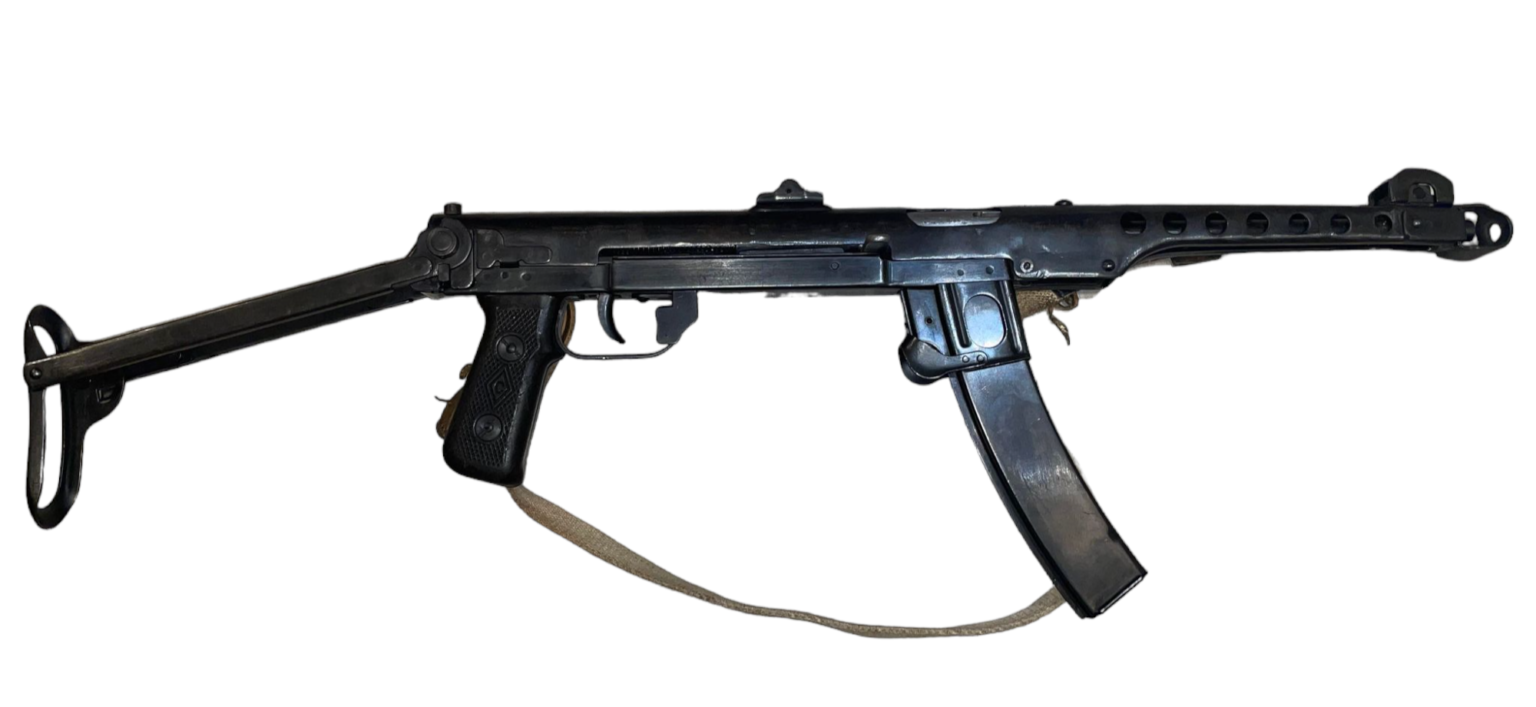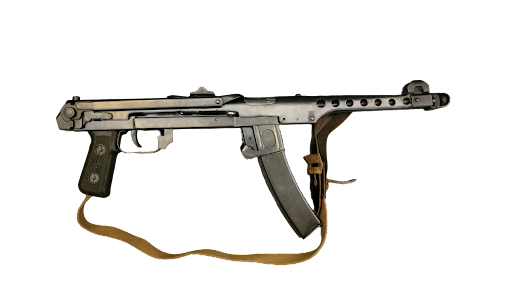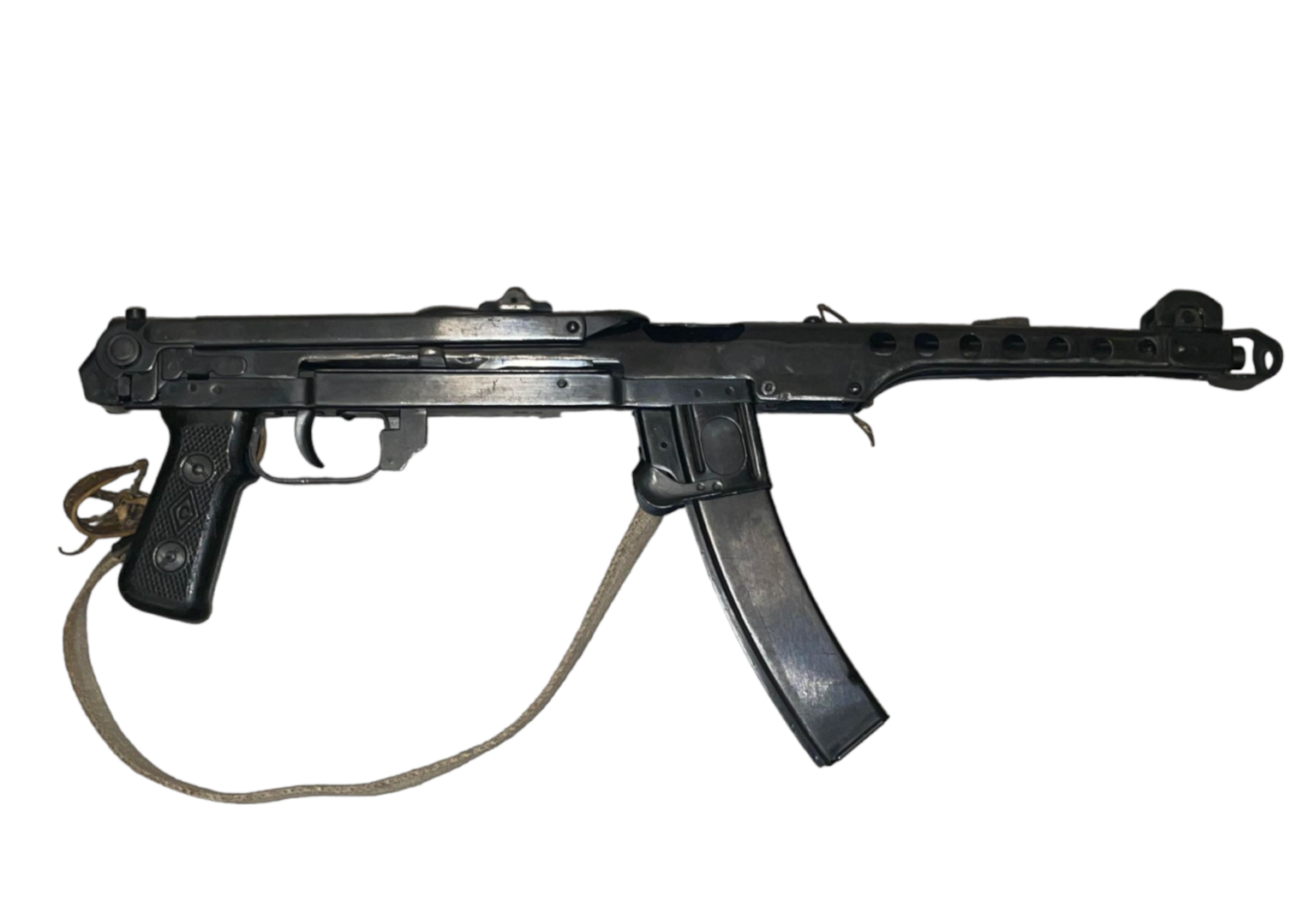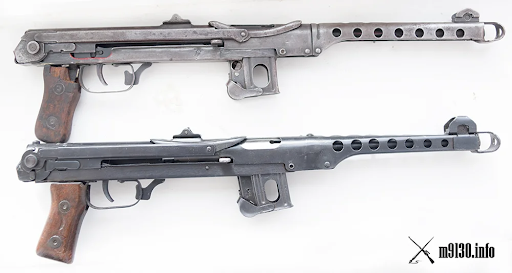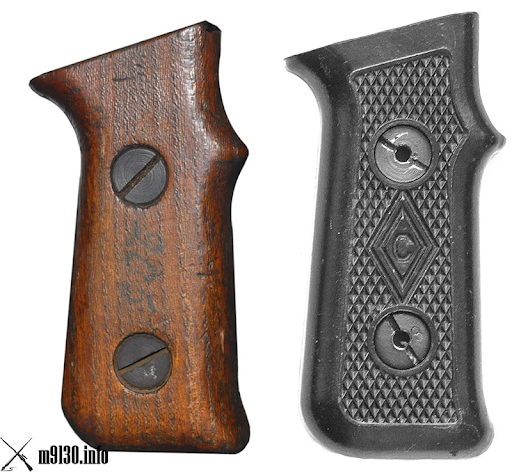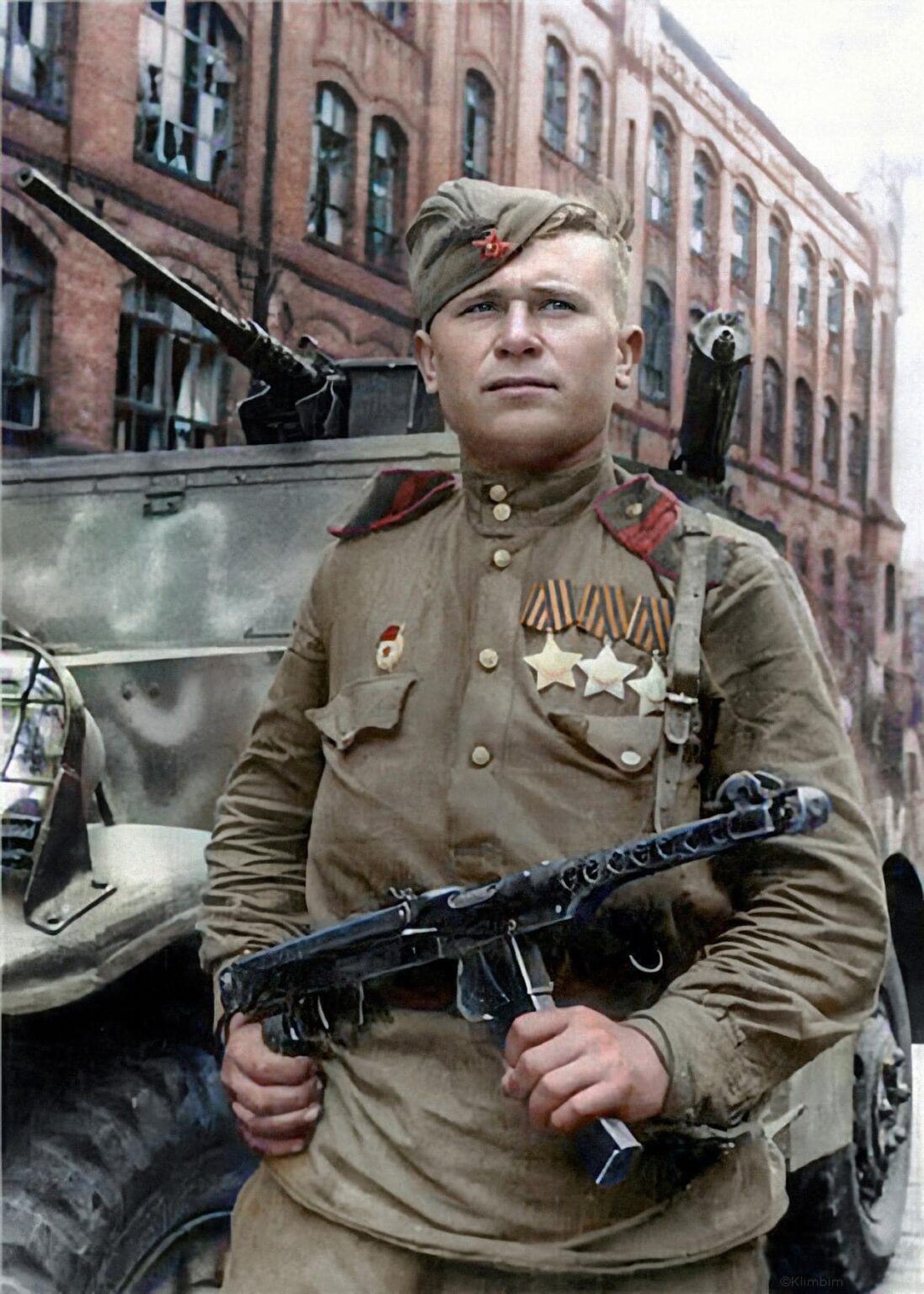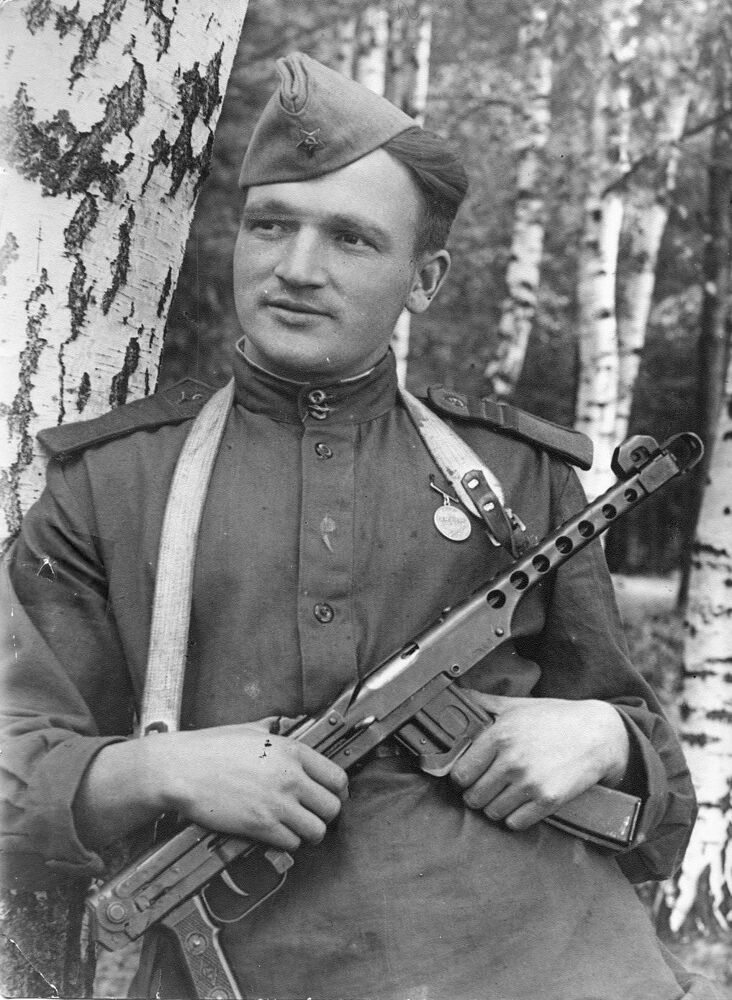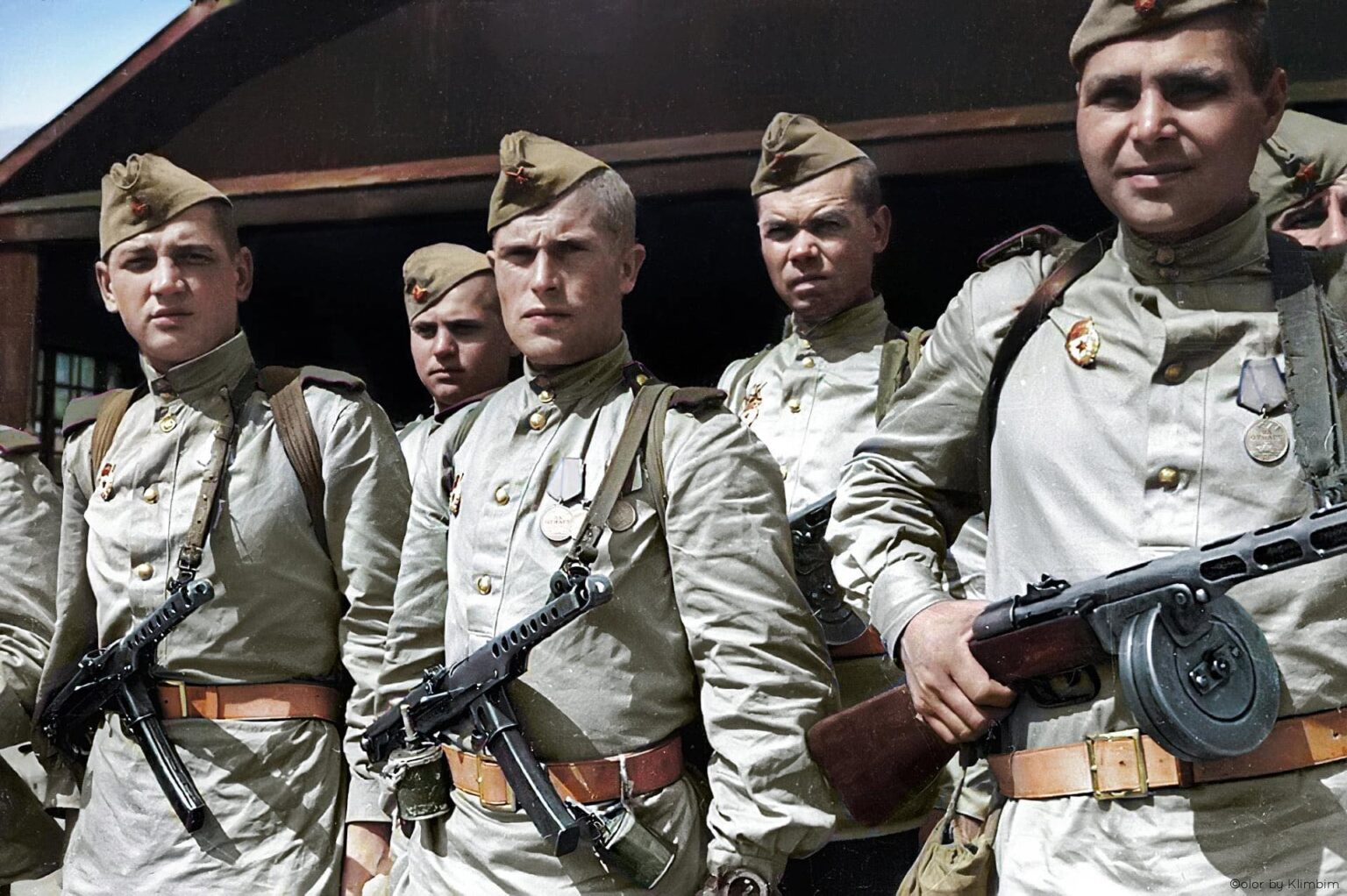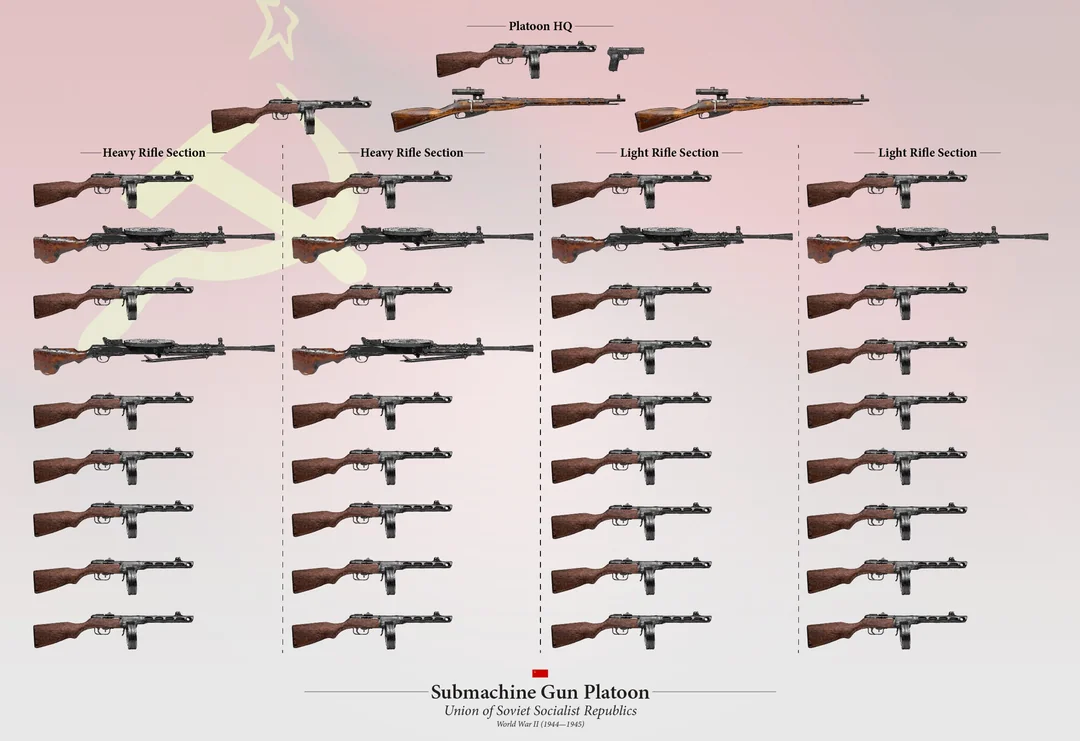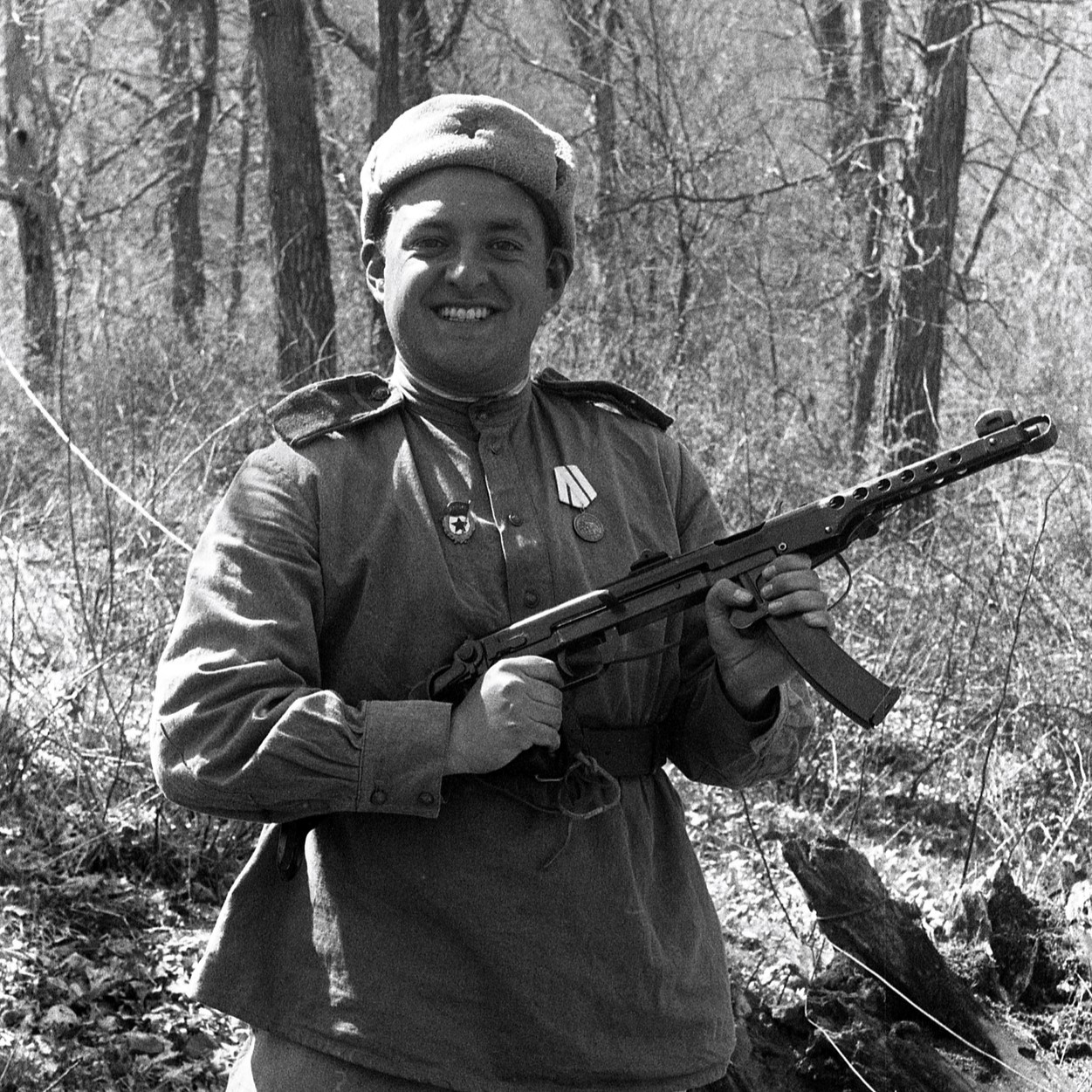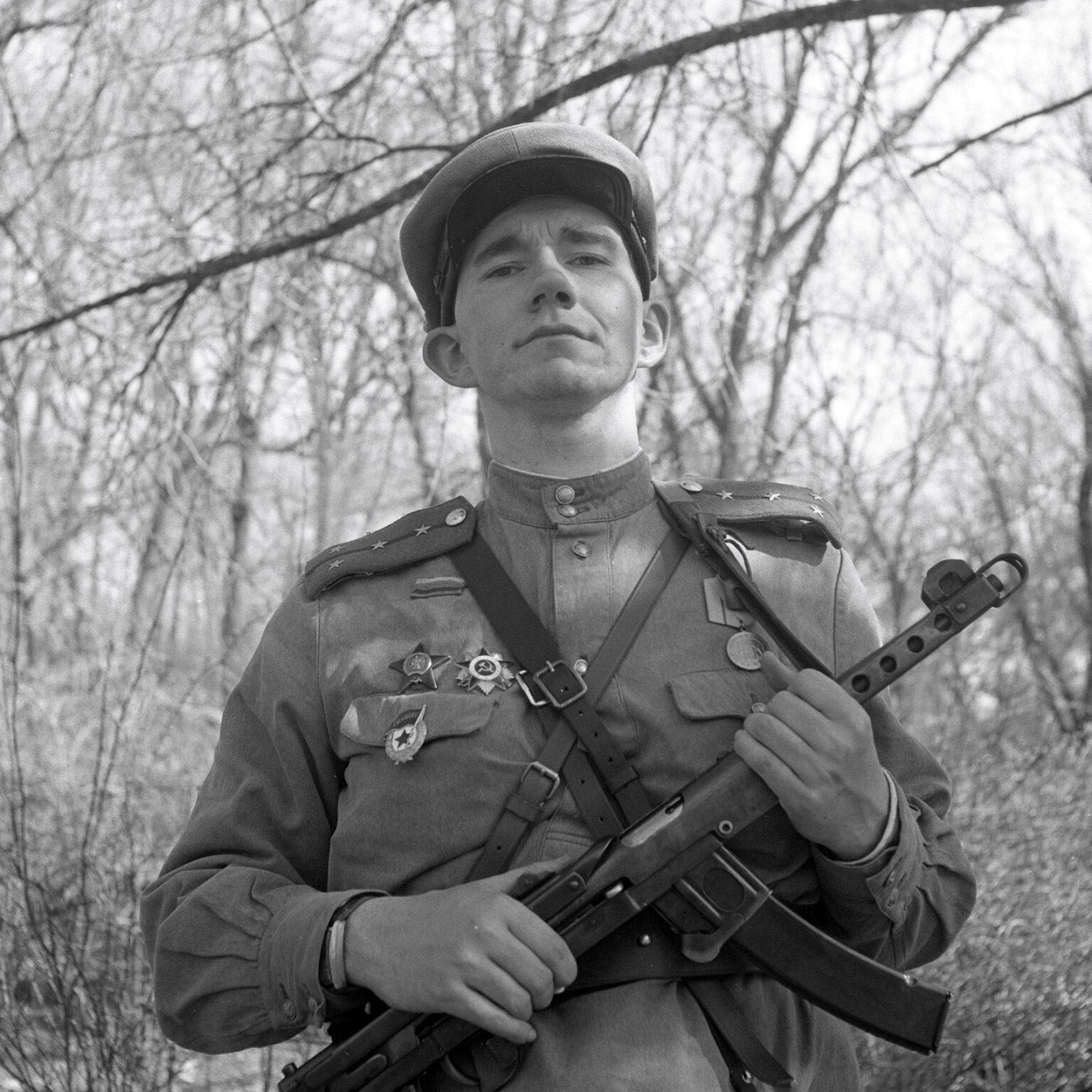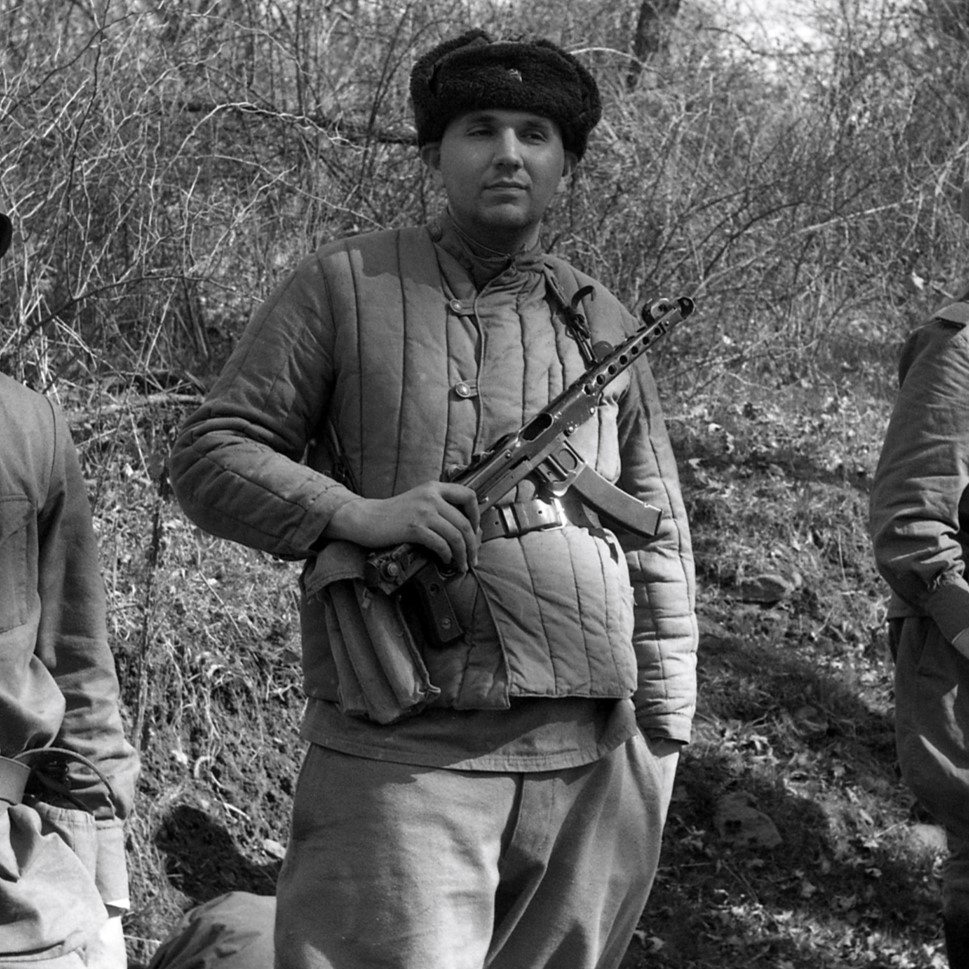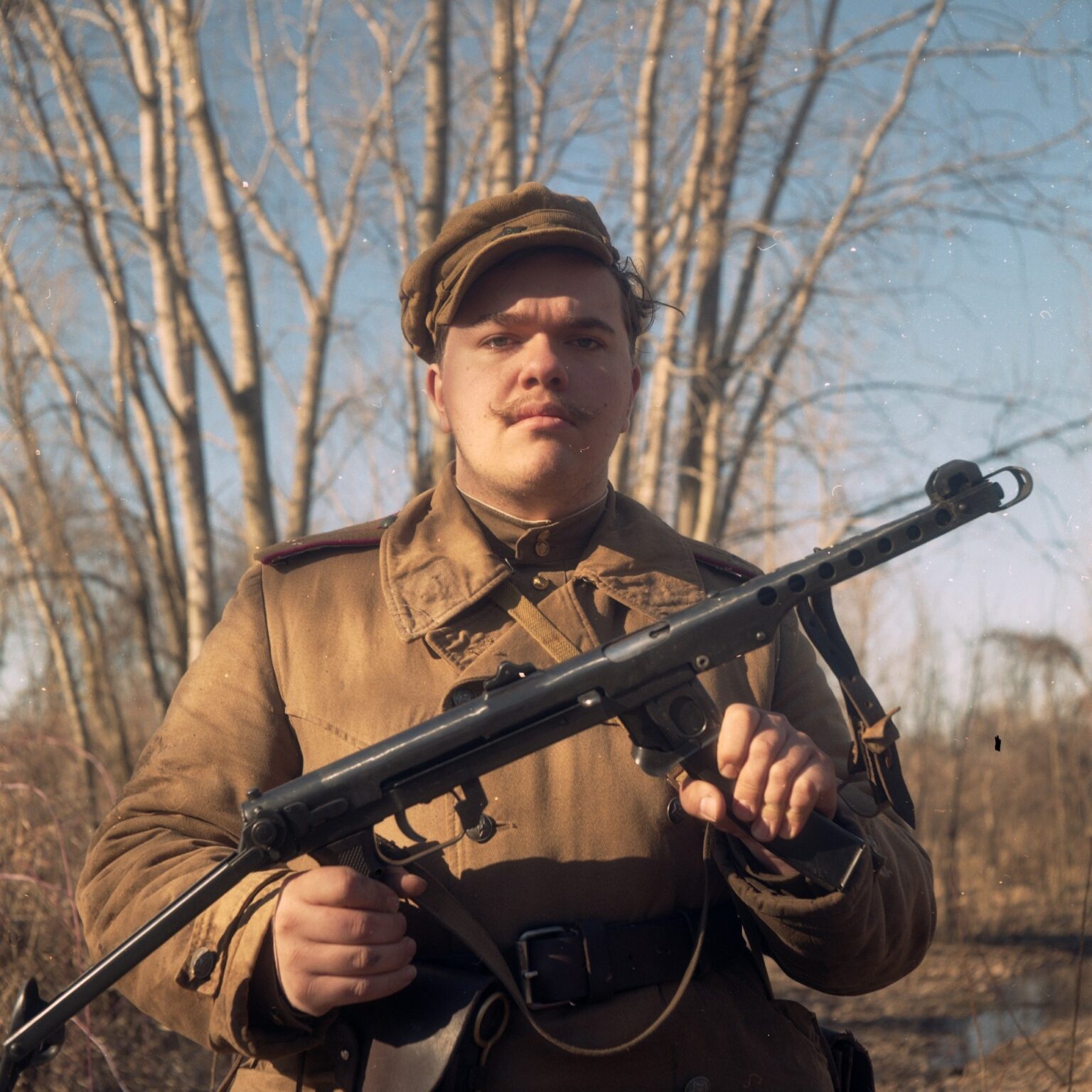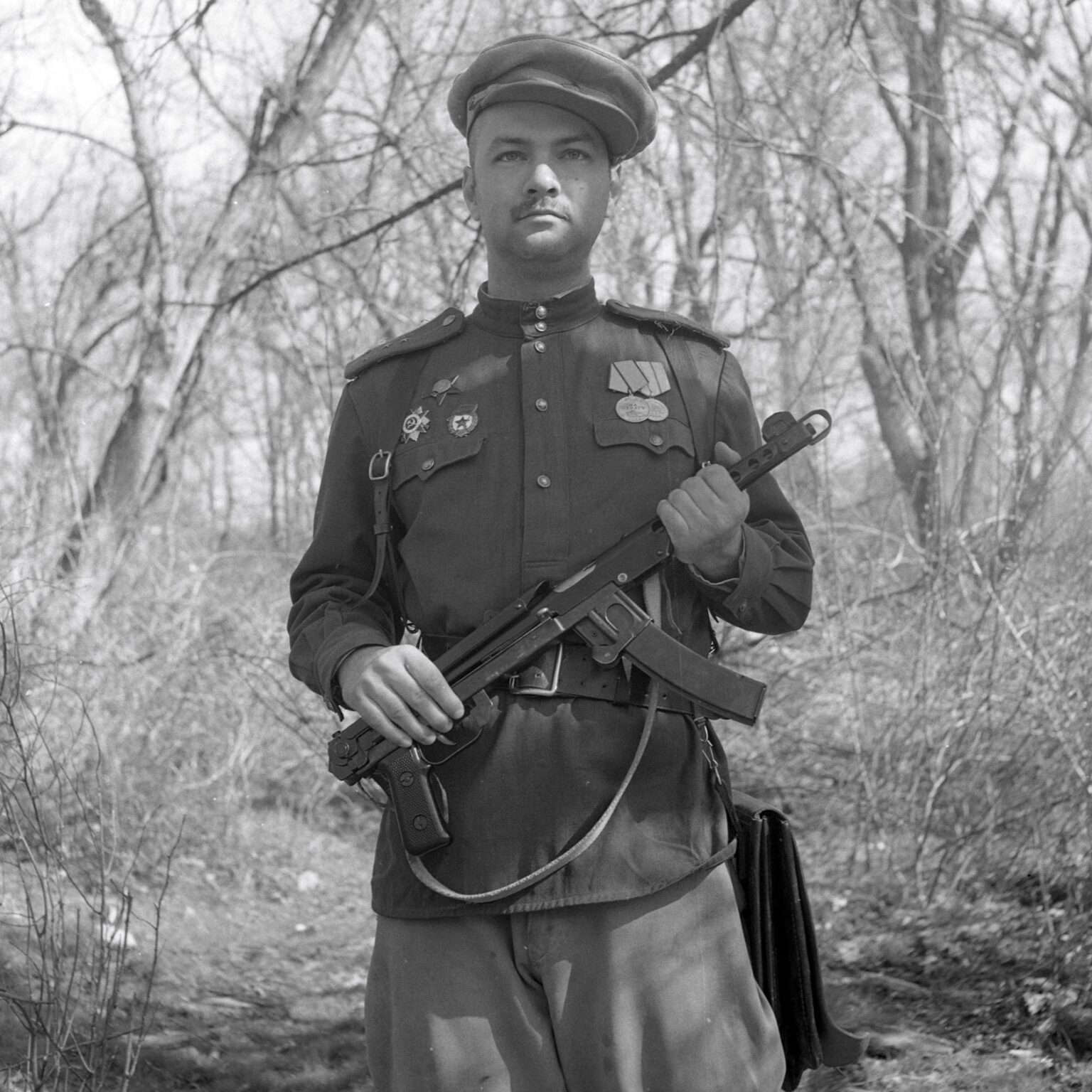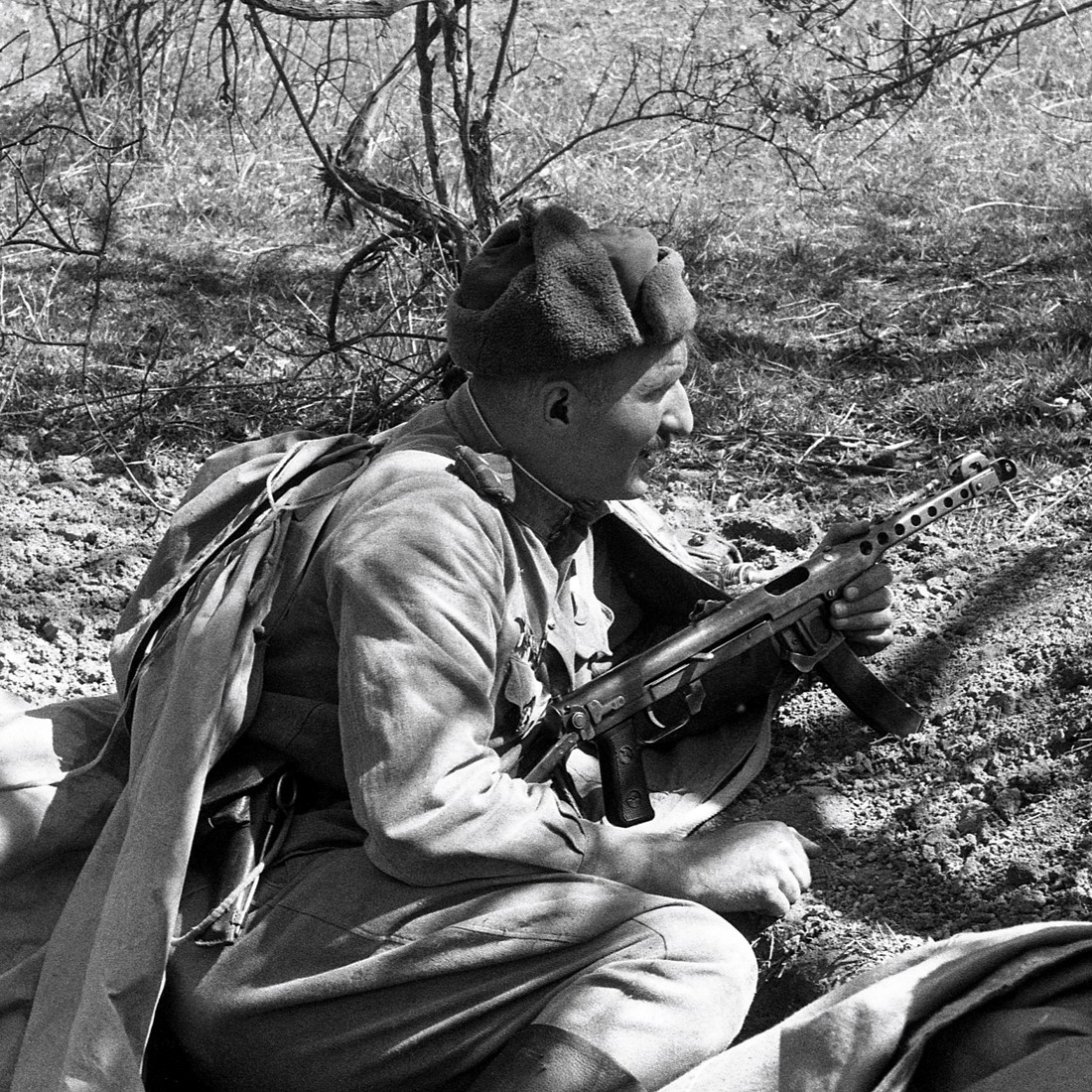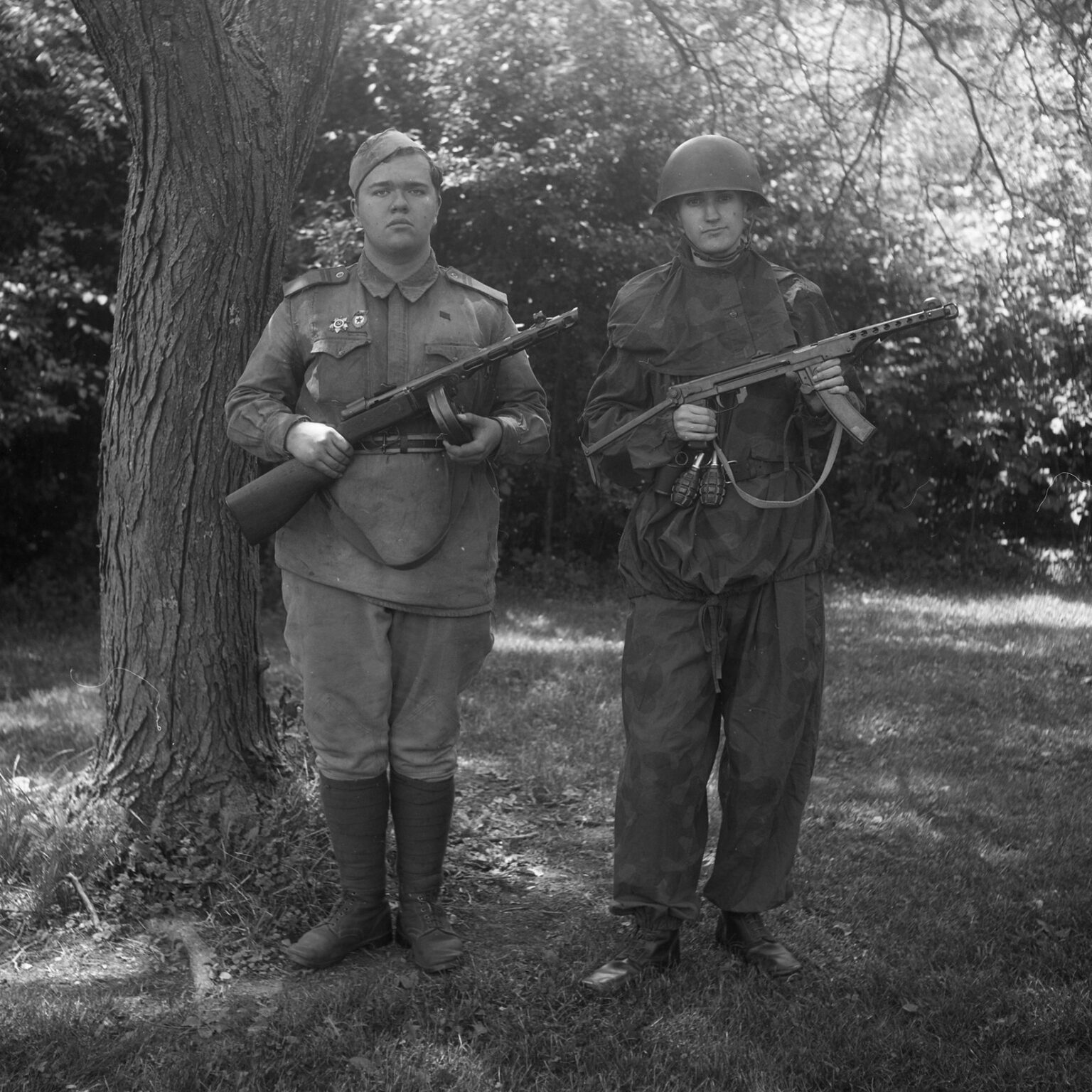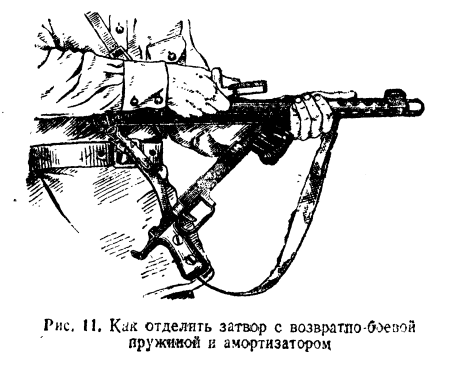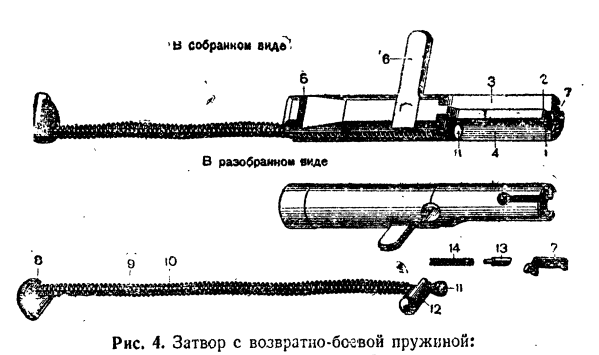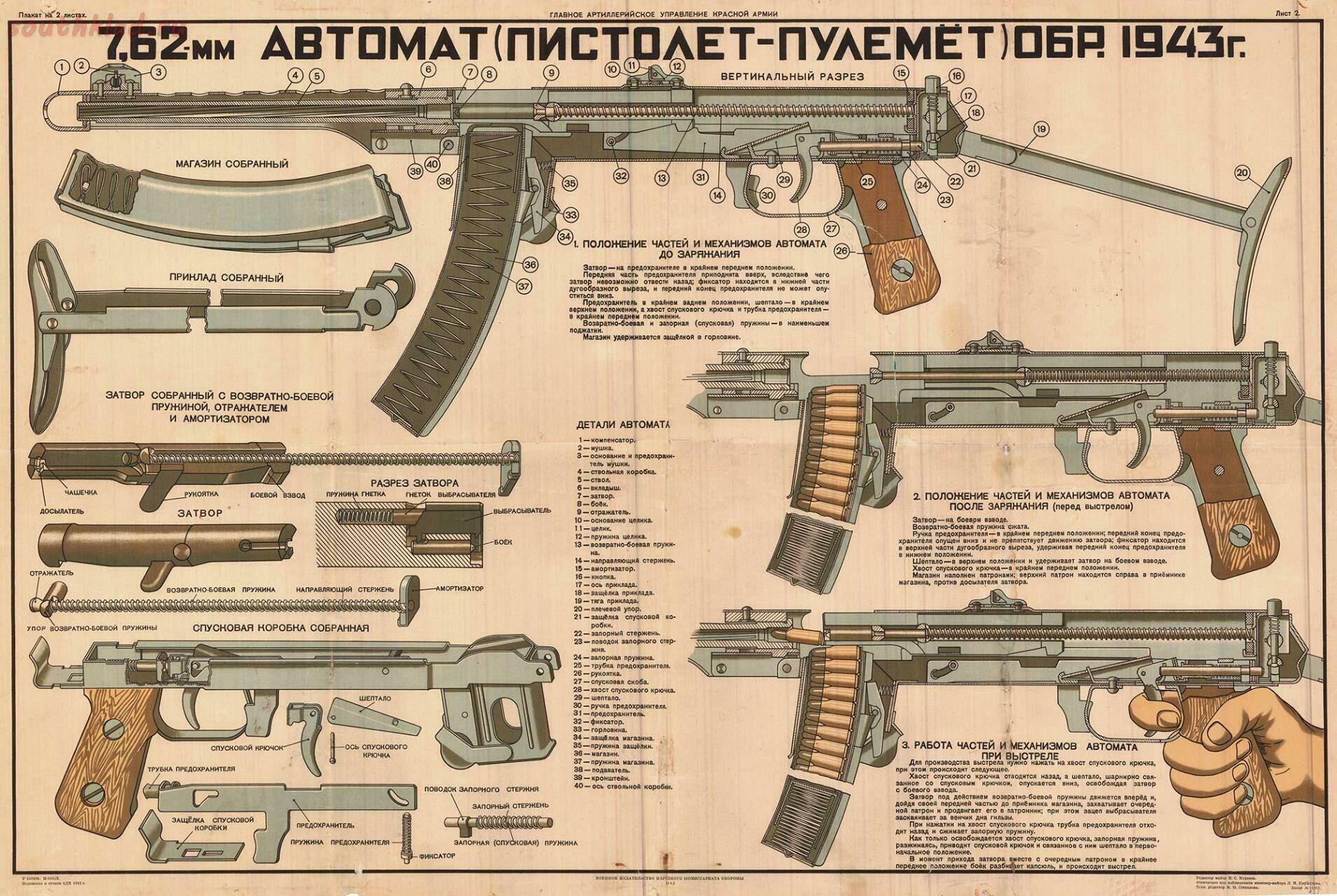The PPS-43
History and Design
The PPS series of submachine guns were designed by Alexei Sudayev starting in 1942 inside besieged Leningrad. At the time, the Red Army was looking for a submachine gun that was further streamlined than the PPSH-41. The design required fewer man hours to produce, less metal waste, less material to produce, and must be lightweight. Sudayev’s design fit the bill perfectly. In mid 1942 Sudayev’s design was put to the test in trials against designs such as Shpagin’s PPSH-2. The PPS-42 was found to be incredibly lightweight, reliable, accurate, and maneuverable when compared to the other designs. The PPS-42 was slightly modified and later became the PPS-43. Like the PPSH before it, the PPS series were chambered in 7.62×25 mm Tokarev, used an open bolt blowback operated system, featured swivel rear sights, had a crude muzzle brake, and was made primarily of stamped steel. The PPS series however exclusively used 35 round stick magazines, had a folding stock, and eventually a safety by the trigger guard. Also unlike the PPSH before it, the PPS was exclusively fully automatic. The PPS has a muzzle velocity of 500m/s, an effective range of 100-150m, and max range of 200m. Soviet firearms of the period where the epitome of simple, cheap, easy to produce, easy to use, and easy to maintain. The PPS series of sub machineguns arguably fit this mold better than any other firearm of the day.
The PPS series of submachine guns were designed by Alexei Sudayev starting in 1942 inside besieged Leningrad. At the time, the Red Army was looking for a submachine gun that was further streamlined than the PPSH-41. The design required fewer man hours to produce, less metal waste, less material to produce, and must be lightweight. Sudayev’s design fit the bill perfectly. In mid 1942 Sudayev’s design was put to the test in trials against designs such as Shpagin’s PPSH-2. The PPS-42 was found to be incredibly lightweight, reliable, accurate, and maneuverable when compared to the other designs. The PPS-42 was slightly modified and later became the PPS-43.
Like the PPSH before it, the PPS series were chambered in 7.62×25 mm Tokarev, used an open bolt blowback operated system, featured swivel rear sights, had a crude muzzle brake, and was made primarily of stamped steel. The PPS series however exclusively used 35 round stick magazines, had a folding stock, and eventually a safety by the trigger guard. Also unlike the PPSH before it, the PPS was exclusively fully automatic. The PPS has a muzzle velocity of 500m/s, an effective range of 100-150m, and max range of 200m. Soviet firearms of the period where the epitome of simple, cheap, easy to produce, easy to use, and easy to maintain. The PPS series of sub machineguns arguably fit this mold better than any other firearm of the day.
Production
It should be noted that the People’s Commissariat of Armament found that switching production from the PPSH to the PPS would not be economically sound. Therefore, PPSs were not to be produced in factories under the Commissariat of Armament and had to be produced elsewhere. Due to the PPS design being primarily stamped metal it was relatively easy for factories that had produced other stamped metal goods to begin producing weapons instead. Thus, both submachine guns were produced in tandem. Small scale production began for the PPS-42 in late 1942/early 1943 in Leningrad. It wasn’t until mid 1943 that mass production began. By the end of 1943, 46,572 PPS-42s were produced. A factory in Moscow also produced a small number of PPS-42s but most were found to be of poor quality and either used as training guns or cutaways. Due to the location of the other three factories in Leningrad the PPS-42s produced there were immediately used in the defense of the city. These field trials proved to be of great use to Sudayev. Using feedback from the field trials he further improved his design. This new design featured an improved safety and redesigned muzzle brake, the overall length was shortened, a further streamlined production process, etc. This new design was submitted for trials and in May 1943 was accepted for service. Thus the PPS-43 was born. The end product was a submachine gun that required only 2.7 man hours to produce, as well as only 6.2 kg or raw material. Mass production of the PPS-43 began in June of 1943 and in Moscow in August of 1943. There were some minor production differences between factories, the main difference being the safety. It was either placed to the side of the trigger guard, or through a slit in the center of it. The Moscow factory also eventually adopted bakelite grips to replace wooden ones. Eventually, in Spring 1944 the design and production of the PPS-43 was standardized. From 1943-1946 roughly 2 million PPS-43s were produced.
It should be noted that the People’s Commissariat of Armament found that switching production from the PPSH to the PPS would not be economically sound. Therefore, PPSs were not to be produced in factories under the Commissariat of Armament and had to be produced elsewhere. Due to the PPS design being primarily stamped metal it was relatively easy for factories that had produced other stamped metal goods to begin producing weapons instead. Thus, both submachine guns were produced in tandem. Small scale production began for the PPS-42 in late 1942/early 1943 in Leningrad. It wasn’t until mid 1943 that mass production began. By the end of 1943, 46,572 PPS-42s were produced. A factory in Moscow also produced a small number of PPS-42s but most were found to be of poor quality and either used as training guns or cutaways. Due to the location of the other three factories in Leningrad the PPS-42s produced there were immediately used in the defense of the city. These field trials proved to be of great use to Sudayev. Using feedback from the field trials he further improved his design. This new design featured an improved safety and redesigned muzzle brake, the overall length was shortened, a further streamlined production process, etc.
The new design was submitted for trials and in May 1943 was accepted for service. Thus the PPS-43 was born. The end product was a submachine gun that required only 2.7 man hours to produce, as well as only 6.2 kg or raw material. Mass production of the PPS-43 began in June of 1943 and in Moscow in August of 1943. There were some minor production differences between factories, the main difference being the safety. It was either placed to the side of the trigger guard, or through a slit in the center of it. The Moscow factory also eventually adopted bakelite grips to replace wooden ones. Eventually, in Spring 1944 the design and production of the PPS-43 was standardized. From 1943-1946 roughly 2 million PPS-43s were produced.
It should be noted that the People’s Commissariat of Armament found that switching production from the PPSH to the PPS would not be economically sound. Therefore, PPSs were not to be produced in factories under the Commissariat of Armament and had to be produced elsewhere. Due to the PPS design being primarily stamped metal it was relatively easy for factories that had produced other stamped metal goods to begin producing weapons instead. Thus, both submachine guns were produced in tandem. Small scale production began for the PPS-42 in late 1942/early 1943 in Leningrad.
It wasn’t until mid 1943 that mass production began. By the end of 1943, 46,572 PPS-42s were produced. A factory in Moscow also produced a small number of PPS-42s but most were found to be of poor quality and either used as training guns or cutaways. Due to the location of the other three factories in Leningrad the PPS-42s produced there were immediately used in the defense of the city. These field trials proved to be of great use to Sudayev. Using feedback from the field trials he further improved his design. This new design featured an improved safety and redesigned muzzle brake, the overall length was shortened, a further streamlined production process, etc.
The new design was submitted for trials and in May 1943 was accepted for service. Thus the PPS-43 was born. The end product was a submachine gun that required only 2.7 man hours to produce, as well as only 6.2 kg or raw material. Mass production of the PPS-43 began in June of 1943 and in Moscow in August of 1943. There were some minor production differences between factories, the main difference being the safety. It was either placed to the side of the trigger guard, or through a slit in the center of it. The Moscow factory also eventually adopted bakelite grips to replace wooden ones. Eventually, in Spring 1944 the design and production of the PPS-43 was standardized. From 1943-1946 roughly 2 million PPS-43s were produced.
The No. 828 NKMV, Moscow factory served as the primary production facility for the PPS-43 submachine gun. This factory played a pivotal role in implementing the final construction changes once they were adopted. Subsequently, the revisions were disseminated to other manufacturing facilities. Between the years 1943 and 1945, this factory was responsible for the production of approximately 530,000 PPS-43 submachine guns.
During the initial production months, spanning from the summer through the autumn of 1943, the factory employed wooden pistol grips on the PPS-43. However, later in the production cycle, it transitioned to the use of bakelite grips. It’s worth noting that this factory (No. 828 NKMV) stood alone in its utilization of bakelite grips, setting it apart from other production facilities. Items manufactured at this factory were distinguishable by a factory marking denoted by the letter “C,” while the serial numbers featured a two-letter prefix followed by three numerical digits.
For individuals seeking to acquire a PPS-43, it is advisable to ensure that you acquire one of the two grip types mentioned. The bakelite grips tend to be more prevalent in the secondary market compared to the wooden grips. Furthermore, it should be noted that bakelite grips bearing a star emblem were postwar additions utilized in the replacement of wooden grips on refurbished PPS-43s.
The No. 828 NKMV, Moscow factory served as the primary production facility for the PPS-43 submachine gun. This factory played a pivotal role in implementing the final construction changes once they were adopted. Subsequently, the revisions were disseminated to other manufacturing facilities. Between the years 1943 and 1945, this factory was responsible for the production of approximately 530,000 PPS-43 submachine guns.
During the initial production months, spanning from the summer through the autumn of 1943, the factory employed wooden pistol grips on the PPS-43. However, later in the production cycle, it transitioned to the use of bakelite grips. It’s worth noting that this factory (No. 828 NKMV) stood alone in its utilization of bakelite grips, setting it apart from other production facilities. Items manufactured at this factory were distinguishable by a factory marking denoted by the letter “C,” while the serial numbers featured a two-letter prefix followed by three numerical digits.
For individuals seeking to acquire a PPS-43, it is advisable to ensure that you acquire one of the two grip types mentioned. The bakelite grips tend to be more prevalent in the secondary market compared to the wooden grips. Furthermore, it should be noted that bakelite grips bearing a star emblem were postwar additions utilized in the replacement of wooden grips on refurbished PPS-43s.
Issuance & Use
Generally, PPS-43s aren’t seen in great numbers until mid/late 1944. They were issued as supplies became available along with the PPSH. As the war progressed, fire power increased more and more. This exponentially increasing firepower was an incredible asset that gave the Soviets the upper hand in battle. By war’s end there was a healthy mix of submachine guns, autoloading rifles, and bolt-action rifles. The PPS was especially favored by troops with special roles such as the airborne. Like the PPSH before it, the PPS was best suited to mid/close quarters combat and proved especially useful in clearing cities and towns.
As the Second World War raged on, no other nation would grow to put greater value on the submachine gun than the Soviet Union. In mid 1942 about 6% of men in a Soviet infantry battalion were equipped with submachine guns. In early 1944 that number increased to 25%, greater than any other military at the time. Soviet doctrine would evolve to have entire battalions organized around the use of submachine guns. The simplicity of the PPSH-41 and eventually the PPS-43 allowed the Soviets to produce massive numbers of submachine guns, equipping regular enlisted men with the PPSH-41 whereas in other militaries submachine guns were reserved for NCOs and officers.
During 1942 the Soviets would implement a regimental submachine gun company, consisting of 3 SMG platoons with 3 SMG squads per platoon. Its job was to support the main force of the regiment during an attack or form the regimental reserve. However, it could be deployed as the regimental commander saw fit, either as a company or separate platoons. Later, in mid 1943, the Soviet Rifle Company would convert one of their rifle platoons into a submachine gun platoon, these men would be equipped with the PPSh-41 (in 1943) and both PPSh-41s and PPS-43 (in 1944 onwards). These platoons on the offensive would be used to attack weak points at the edge of the enemy’s line. If the enemy had no weak point in their line, the platoon would split into their respective squads and cover gaps between the rifle platoons and flanks in the line. On the defensive these platoons would form the second echelon, defending the company HQ and rear from flanks or infiltrators. At night the submachine gun platoons would be brought up to the first echelon of the defense to take advantage of the low visibility, as well as compensate for it.
The incorporation of the Submachine Gun Platoon at this level signified a significant shift in Soviet doctrine during the period in question. In the earlier stages of the war, submachine guns were primarily utilized as substitutes for machine guns in cases where the DP-27 was in short supply. However, as the war progressed, the Soviet military began to rely far more heavily on submachine guns than any other nation during World War II. In contrast, the United States predominantly allocated submachine guns to vehicle crews and had, by the mid-war period, removed them from the standard rifle company. While there was an informal practice of concentrating submachine guns among paratroopers, this practice represented an exception rather than the norm. The M1 Garand remained the most prevalent firearm within the standard rifle company. In the case of the German rifle company, submachine guns were exclusively issued to officers and squad leaders, with a somewhat analogous approach to the Submachine Gun Platoon being implemented in the form of the “Sturmgewehr-armed Sturmzug”, albeit on a considerably smaller scale. Towards the conclusion of the war, it became increasingly evident to Soviet military leaders how valuable submachine guns were in the context of assault operations.
Each sub gun platoon had 30 submachine guns, that brought the total number up to ~50 submachine guns per standard rifle company. That meant by early 1944, 35% of the men in a rifle company had submachine guns. However, this wasn’t always the case due to unit attrition in combat and potential supply issues. This is still an incredible feat for a military of that time. From there ideally you are looking at ~150 submachine guns per Rifle Battalion, ~450 submachine guns per Rifle Regiment, and ~1,710 submachine guns per Rifle Division (including the regimental submachine gun companies [3 per division], not including Artillery and Anti-Tank Regiments and Battalions per Rifle Division). The full number then, including all supporting units would be ~2,000 submachine guns per Rifle Division. This is a level of firepower the Germans could not hope to match in the latter 2 years of the war. Do note that these are the numbers as on paper, which doesn’t always correlate to what was seen on the frontlines. By the end of the war the Soviets had produced some ~8 million total submachine guns (not including those received via lend lease), compared to the approximately 1.1 – 1.3 million total submachine guns produced by the Germans. The PPS-43 helped play its part in those production numbers and the implementation of Soviet submachine platoons and regimental submachine gun companies.
The incorporation of the Submachine Gun Platoon at this level signified a significant shift in Soviet doctrine during the period in question. In the earlier stages of the war, submachine guns were primarily utilized as substitutes for machine guns in cases where the DP-27 was in short supply. However, as the war progressed, the Soviet military began to rely far more heavily on submachine guns than any other nation during World War II. In contrast, the United States predominantly allocated submachine guns to vehicle crews and had, by the mid-war period, removed them from the standard rifle company. While there was an informal practice of concentrating submachine guns among paratroopers, this practice represented an exception rather than the norm. The M1 Garand remained the most prevalent firearm within the standard rifle company.
In the case of the German rifle company, submachine guns were exclusively issued to officers and squad leaders, with a somewhat analogous approach to the Submachine Gun Platoon being implemented in the form of the “Sturmgewehr-armed Sturmzug”, albeit on a considerably smaller scale. Towards the conclusion of the war, it became increasingly evident to Soviet military leaders how valuable submachine guns were in the context of assault operations.
Each sub gun platoon had 30 submachine guns, that brought the total number up to ~50 submachine guns per standard rifle company. That meant by 1944, 35% of the men in a rifle company had submachine guns. However, this wasn’t always the case due to unit attrition in combat and potential supply issues. This is still an incredible feat for a military of that time. From there ideally you are looking at ~150 submachine guns per rifle battalion, ~450 submachine guns per rifle regiment, and ~1,710 submachine guns per rifle division (including the regimental submachine gun companies [3 per division], not including Artillery and Anti-Tank Regiments and Battalions).
This is a level of firepower the Germans could not hope to match in 1944. Do note that these are the numbers as on paper, which doesn’t always correlate to what was seen on the frontlines. By the end of the war the Soviets had produced some ~8 million total submachine guns (not including those received via lend lease), compared to the approximately 1.1 – 1.3 million total submachine guns produced by the Germans. The PPS-43 helped play its part in those production numbers and the implementation of Soviet submachine platoons and regimental submachine gun companies.

Submachine Gun Platoon (1 Officer and 39 Enlisted each)
- Platoon Commander, Jr. Lieutenant or Lieutenant, armed with 1 PPSh-41/PPS-43 Submachine Gun and 1 TT Pistol/Nagant Revolver
- Deputy Platoon Commander, Sr. Sergeant, armed with 1 PPSh-41/PPS-43 Submachine Gun
- 2× Snipers, Private, armed with 1 Mosin-Nagant PU Sniper Rifle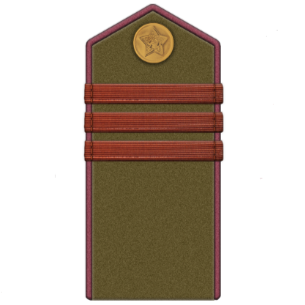
2× Light Rifle Sections (9 Enlisted each)
- Section Commander, Jr. Sergeant or Sergeant, armed with 1 PPSh-41/PPS-43 Submachine Gun
- Deputy Section Commander, Yefreytor, armed with PPSh-41/PPS-43 Submachine Gun
- Light Machine Gunner, Private, armed with 1 DP-27 Light Machine Gun
- Assistant Machine Gunner, Private, armed with 1 PPSh-41/PPS-43 Submachine Gun
- 5× Riflemen, Private, armed with 1 PPSh-41/PPS-43 Submachine Gun
2× Heavy Rifle Sections (9 Enlisted each)
- Section Commander, Jr. Sergeant or Sergeant, armed with 1 PPSh-41/PPS-43 Submachine Gun
- Deputy Section Commander (Senior Rifleman), Yefreytor, armed with 1 PPSh-41/PPS-43 Submachine Gun
- 2× Light Machine Gunners, Private, armed with 1 DP-27 Light Machine Gun
- 2× Assistant Machine Gunners, Private, armed with 1 PPSh-41/PPS-43 Submachine Gun
- 3× Riflemen, Private, armed with 1 PPSh-41/PPS-43 Submachine Gun

Submachine Gun Platoon (1 Officer and 39 Enlisted each)
- Platoon Commander, Jr. Lieutenant or Lieutenant, armed with 1 PPSh-41/PPS-43 Submachine Gun and 1 TT Pistol/Nagant Revolver
- Deputy Platoon Commander, Sr. Sergeant, armed with 1 PPSh-41/PPS-43 Submachine Gun
- 2× Snipers, Private, armed with 1 Mosin-Nagant PU Sniper Rifle
2× Light Rifle Sections (9 Enlisted each)
- Section Commander, Jr. Sergeant or Sergeant, armed with 1 PPSh-41/PPS-43 Submachine Gun
- Deputy Section Commander, Yefreytor, armed with 1 Mosin-Nagant or SVT-40 Rifle
- Light Machine Gunner, Private, armed with 1 DP-27 Light Machine Gun
- Assistant Machine Gunner, Private, armed with 1 PPSh-41/PPS-43 Submachine Gun
- 5× Riflemen, Private, armed with 1 PPSh-41/PPS-43 Submachine Gun
2× Heavy Rifle Sections (9 Enlisted each)
- Section Commander, Jr. Sergeant or Sergeant, armed with 1 PPSh-41/PPS-43 Submachine Gun
- Deputy Section Commander (Senior Rifleman), Yefreytor, armed with 1 PPSh-41/PPS-43 Submachine Gun
- 2× Light Machine Gunners, Private, armed with 1 DP-27 Light Machine Gun
- 2× Assistant Machine Gunners, Private, armed with 1 PPSh-41/PPS-43 Submachine Gun
- 3× Riflemen, Private, armed with 1 PPSh-41/PPS-43 Submachine Gun

Submachine Gun Platoon (1 Officer and 39 Enlisted each)
- Platoon Commander, Jr. Lieutenant or Lieutenant, armed with 1 PPSh-41/PPS-43 Submachine Gun and 1 TT Pistol/Nagant Revolver
- Deputy Platoon Commander, Sr. Sergeant, armed with 1 PPSh-41/PPS-43 Submachine Gun
- 2× Snipers, Private, armed with 1 Mosin-Nagant PU Sniper Rifle
2× Light Rifle Sections (9 Enlisted each)
- Section Commander, Jr. Sergeant or Sergeant, armed with 1 PPSh-41/PPS-43 Submachine Gun
- Deputy Section Commander, Yefreytor, armed with 1 Mosin-Nagant or SVT-40 Rifle
- Light Machine Gunner, Private, armed with 1 DP-27 Light Machine Gun
- Assistant Machine Gunner, Private, armed with 1 PPSh-41/PPS-43 Submachine Gun
- 5× Riflemen, Private, armed with 1 PPSh-41/PPS-43 Submachine Gun
2× Heavy Rifle Sections (9 Enlisted each)
- Section Commander, Jr. Sergeant or Sergeant, armed with 1 PPSh-41/PPS-43 Submachine Gun
- Deputy Section Commander (Senior Rifleman), Yefreytor, armed with 1 PPSh-41/PPS-43 Submachine Gun
- 2× Light Machine Gunners, Private, armed with 1 DP-27 Light Machine Gun
- 2× Assistant Machine Gunners, Private, armed with 1 PPSh-41/PPS-43 Submachine Gun
- 3× Riflemen, Private, armed with 1 PPSh-41/PPS-43 Submachine Gun
What to Expect as a Reenactor
Many of the PPS-43s on the market today are postwar Polish copies that are more or less exactly the same as wartime Soviet models. The main thing that needs replacing are the bakelite grips with either wooden grips or bakelite grips from the Moscow factory etched with the letter “C” in the center. Box magazines are currently somewhat easy to find and are the same regardless of when they were produced. It is important to be aware of and follow all local/state/federal laws when purchasing magazines and parts kits. For reenacting purposes, these parts kits will need to be converted into BFONGs (Blank Fire Only Non-Gun). Conversion into a BFONG allows fully automatic fire. This, along with the original barrel length and functioning folding stock are allowed since a BFONG is not a firearm and cannot fire live ammo whatsoever. Semi auto guns and those with extended barrels are generally not as useful in a reenacting context. We recommend to avoid modern reproductions of the PPS-43, such as the Pioneer Arms PPS-43C. They are only fit for display events and even then, they are of an incorrect build and are too dissimilar from original Soviet and early post war Polish ones. If possible modern reproductions of WWII firearms should be avoided in a reenacting context. It is also worth noting that the PPS-43 was not captured in great numbers by the Germans due to the tide of the war turning against them. No German reenactor should ever field a “captured” PPS-43. The PPS-43 is the cheapest WWII era BFONG to get and is far more reliable than PPSh-41 BFONGs, which can encounter jams more frequently due to its much higher rate of fire. If you are a Soviet reenactor, (especially if you focus more on late war) we cannot recommend the PPS-43 more. As the cheapest, and most reliable WWII submachine gun, you will get immense use from it at events.
Many of the PPS-43s on the market today are postwar Polish copies that are more or less exactly the same as wartime Soviet models. The main thing that needs replacing are the bakelite grips with either wooden grips or bakelite grips from the Moscow factory etched with the letter “C” in the center. Box magazines are currently somewhat easy to find and are the same regardless of when they were produced. It is important to be aware of and follow all local/state/federal laws when purchasing magazines and parts kits. For reenacting purposes, these parts kits will need to be converted into BFONGs (Blank Fire Only Non-Gun). Conversion into a BFONG allows fully automatic fire. This, along with the original barrel length and functioning folding stock are allowed since a BFONG is not a firearm and cannot fire live ammo whatsoever. Semi auto guns and those with extended barrels are generally not as useful in a reenacting context.
We recommend to avoid modern reproductions of the PPS-43, such as the Pioneer Arms PPS-43C. They are only fit for display events and even then, they are of an incorrect build and are too dissimilar from original Soviet and early post war Polish ones. If possible modern reproductions of WWII firearms should be avoided in a reenacting context. It is also worth noting that the PPS-43 was not captured in great numbers by the Germans due to the tide of the war turning against them. No German reenactor should ever field a “captured” PPS-43. The PPS-43 is the cheapest WWII era BFONG to get and is far more reliable than PPSh-41 BFONGs, which can encounter jams more frequently due to its much higher rate of fire. If you are a Soviet reenactor, (especially if you focus more on late war) we cannot recommend the PPS-43 more. As the cheapest, and most reliable WWII submachine gun, you will get immense use from it at events.
Teardown & Maintenance
Teardown of the PPS is relatively simple. There are essentially two main pieces: 1. The receiver and 2. The bolt. To take the bolt out simply press the receiver catch forward and push down on the barrel. This will separate the upper and lower receiver giving access to the bolt. Take the bolt out and separate it from the spring and buffer. Clean the inside of the receiver, the bolt and spring. Make sure to not only oil but use gun lube as well. A submachine gun has considerably more wear on it due to the high fire rate and metal on metal contact. The lube is a better buffer than oil, prevents increased wear, and helps the parts move smoothly. Below is a step by step guide for basic disassembly from the 1944 manual.
Sources:
McNab, C. (2014). Soviet Submachine Guns of World War II: PPD-40, PPSh-41 and PPS. Osprey Publishing.
Need help! Early PPS43 – Page 4. (n.d.). https://www.warrelics.eu/forum/world-firearms/early-pps43-150009-4/
PPS Sudaev submachine gun | m9130.info. (n.d.). m9130.info. https://www.m9130.info/pps-sudaev-submachine-gun
Приближая Победу: «Отец солдата» и его боевой побратим | Информационно-аналитический портал. (n.d.). https://www.odnarodyna.org/content/priblizhaya-pobedu-otec-soldata-i-ego-boevoy-pobratim
“Company of Submachine Gunners.” ВОЕННАЯ ЛИТЕРАТУРА –[ уставы и законы ]– боевой устав пехоты Красной Армии (1942). часть 2. Accessed March 10, 2023. http://militera.lib.ru/regulations/russr/1942_bup/11.html.
Штат стрелкового полка №04/551 от 10.12.1942. – “Staff of the rifle regiment No. 04/551 dated 12/10/1942.”


